Abstract
Bauxite mining, catalyzed by the escalating global demand for aluminum, leads to serious environmental repercussions, necessitating the development of efficient land rehabilitation techniques. This study presents a sustainable solution for post-bauxite mining land rehabilitation by leveraging red mud waste and cow manure fertilizer. Applied in PT Antam, Sanggau Regency, West Kalimantan, this research examines the potential of these ameliorants to restore ecological functions and promote the growth of Albizia falcata plants. Our findings reveal a remarkable enhancement in soil pH levels and nutrient availability (N, P, K, Ca, Mg, and Na) when applying a blend of 10% red mud and 20% cow manure fertilizer. Consequently, a significant improvement in the growth of Albizia falcata plants by factors ranging from 8 to 13 times was recorded. These results, alongside potential economic benefits, highlight the promise of this approach not to only confront the challenges posed by bauxite mining but also to contribute to global land rehabilitation strategies. While this study provides substantial insights, it recommends further exploration of this method involving diverse plant species, treatments with different ameliorants, and a broader range of observed variables. The study underscores the critical role of government intervention through stringent regulations and the need for a more comprehensive environmental and cost-benefit analysis to foster sustainable mining practices and responsible land rehabilitation.
1. Introduction
The expanding global demand for aluminum has catalyzed a surge in bauxite mining across the globe [1,2]. This mining process necessitates the removal of vegetation, topsoil, and overburden layers, yielding severe environmental repercussions, including soil degradation, habitat alterations, and landscape transformations [3,4]. Issues stemming from bauxite mining frequently include ecosystem damage, water and air pollution, landscape degradation, waste management difficulties, and socio-economic impacts [5,6].
Recent academic research has underscored the importance of comprehensive sustainable mining strategies in confronting environmental issues linked with mining operations, notably in deep mines. Dong et al. (2019) stressed the role of cleaner production, an integrative preventive environmental approach, in reducing the ecological impacts of mining [7]. This research brought to light developments and new perspectives on environmental issues and deep mining strategies for cleaner production in mines. Their investigations offered a summary of the general impacts of the mining industry on the ecological environment, presented remedies for ecological contamination caused by tailings dams, and recommended distinct strategies for safer and more effective resource extraction in deep mines. In a parallel vein, Cai et al. (2021) introduced vital engineering technologies intended for green, intelligent, and sustainable development in deep metal mines [8]. This research drew attention to the engineering hurdles that arise in the deep mining of metal mineral resources and suggested a variety of technologies and innovative methods to address these challenges.
Despite these challenges, the economic significance of bauxite mining, including providing essential mineral resources such as aluminum, creating employment opportunities, and fostering innovation and technological advancement, cannot be understated [9,10,11,12,13]. Moreover, efficient post-mining land rehabilitation is imperative for ensuring the sustainability of mining activities [14,15]. A solitary bauxite mine can impact over 100 hectares of land annually, thereby underlining the urgent need for stringent regulations and intervention strategies to mitigate the substantial environmental effects [16,17].
Post-mining land rehabilitation techniques are instrumental in restoring ecological functions, preventing additional environmental harm, adhering to regulations, and promoting sustainable environmental conservation [18,19,20]. Such techniques can facilitate the restoration of former mining sites to their natural state, recovering soil productivity, reinstating biodiversity, and balancing water and nutrient cycles, thus aligning with the principles of sustainable development and responsible mining practices [21,22].
To tackle the environmental hurdles associated with post-mining land, this research introduces a rehabilitation method that leverages red mud waste and organic materials for land improvement [23]. Red mud waste, a byproduct of bauxite ore refinement, when amalgamated with organic matter like cow manure fertilizer, can efficaciously augment soil pH and enhance nutrient retention [24,25,26]. This method also harbors economic benefits such as improved availability of wood raw materials, decreased production costs, novel business opportunities, enhanced business sustainability and reputation, and diversified business portfolios, thus addressing the scarcity of wood resources and curtailing environmental damage incurred through excessive limestone exploitation [27,28,29].
The present study not only devises pragmatic solutions to confront economic, social, and environmental challenges related to bauxite mining but also contributes to the development of efficient land rehabilitation techniques applicable globally. By adhering to regulations and implementing these techniques, mining firms can effectively and efficiently meet their land rehabilitation obligations, bringing benefits to both the environment and local communities [30,31]. Therefore, the appropriate management of post-mining land is integral to mitigating adverse environmental impacts and fostering sustainable mining practices, underscoring the crucial role of governmental intervention via stringent regulations given the considerable macro-environmental implications.
2. Materials and Methods
This year-long study was undertaken on the premises of PT Antam in Sanggau Regency, West Kalimantan, with soil chemical analyses executed by the Soil Chemistry and Fertility Laboratory of the Faculty of Agriculture at Tanjungpura University. The research implemented a factorial arrangement in a completely randomized block design, incorporating eight treatments. These treatments included R0 (100% Ultisol soil), R1 (95% Ultisol soil + 5% red mud), R2 (90% Ultisol soil + 5% red mud + 5% cow manure), R3 (85% Ultisol soil + 5% red mud + 10% cow manure), R4 (80% Ultisol soil + 10% red mud + 15% cow manure), R5 (70% Ultisol soil + 10% red mud + 20% cow manure), R6 (70% Ultisol soil + 15% red mud + 15% cow manure), and R7 (60% Ultisol soil + 15% red mud + 25% cow manure).
In this experiment, a total of 128 Albizia falcata seedlings were engaged. Eight treatments were devised, each comprising four replications, with each replication including six seedlings. These seedlings were systematically planted at an interval of 3 × 3 m, leading to the presence of 24 Albizia falcata seedlings within each treatment group. Subsequently, the Albizia falcata seedlings were cultivated on post-bauxite mining land in alignment with the predetermined planting medium treatments. To promote the growth of these seedlings, organic pots were utilized as containers for the planting medium. The composition of these organic pots consisted of a blend of 80% cow manure compost and 20% red mud. Thereafter, planting medium mixtures corresponding to each treatment (eight in total) were filled into the organic pots. The planting medium within these organic pots was then incubated for a span of two weeks to adequately prepare the medium prior to the planting of the Albizia falcata seedlings.
Sequentially, soil samples were extracted for chemical properties analysis. Soil pH was ascertained via a pH meter with pH 7.0 and pH 4.0 buffer solutions [32], while the organic carbon content was established via the Walkey and Black wet oxidation method [33]. Total nitrogen content was quantified employing the Kjeldahl method [34], available phosphorus through the Bray-I method [35], and exchangeable potassium (K+), calcium (Ca2+), magnesium (Mg2+), and sodium (Na+) using the NH4Oac 1 N pH 7 extraction method [36]. The cation exchange capacity (CEC) was evaluated using the indophenol blue method [37].
Subsequently, Albizia falcata seedlings, two months old and approximately 62 cm in height, were planted in each organic pot. Growth parameters, encompassing plant height and stem diameter, were measured upon the plants’ attaining 10 weeks of age. The gathered data were then subjected to statistical analysis, utilizing the F-test and Duncan’s multiple range test (DMRT) at a 5% significance level [38].
3. Results and Discussion
3.1. Description of Soil Fertility in Post-Mining Bauxite Tailings
The post-mining bauxite tailings soil is predominantly composed of gravel with a small amount of sand, and the upper layer is mostly gravel, making it challenging for vegetation to thrive [28,39]. Vegetation that does manage to grow in such areas tends to be sparse, dry, and stunted. To enhance the physical properties of the soil in former bauxite tailings, it is recommended to plant fast-growing species with a high leaf count. The decomposition of stems, branches, and dead leaves, which integrate with the soil, can improve soil fertility and enhance its physical properties [40,41].
An effective method to increase soil pH and nutrient availability is through the addition of red mud. Red mud not only provides these benefits but also enhances several physical properties of the soil due to its clay content of 36.58%. Table 1 presents some of the chemical properties of red mud that contribute to these improvements.

Table 1.
Chemical properties of the soil, red mud, and cow manure before treatment.
Table 1 presents the pH values of red mud from PT. ICA, which can be used in various types of soil. Red mud not only serves as a nutrient source but also helps maintain a balanced nutrient profile in the soil. Its application is expected to enhance soil pH and base saturation in post-bauxite mining land, promoting the growth of Albizia falcata.
3.2. Soil Nutrient Availability
Table 2 provides the results of soil nutrient availability analysis for N, P, K, Ca, Mg, and Na due to the influence of red mud and cow manure treatments.

Table 2.
Soil pH and nutrient availability of N, P, K, Ca, Mg, and Na after incubation with red mud and cow manure treatments.
3.2.1. Reaction (pH) in Soil after Incubation
Table 2 demonstrates that treatment R5 (combination of 70% Ultisol soil + 10% red mud + 20% cow manure) significantly influenced soil pH after incubation compared to other treatments. However, treatment R7 (a combination of 60% Ultisol soil + 15% red mud + 25% cow manure) resulted in a decrease in soil pH. This decrease can be attributed to the higher amount of red mud and cow manure added in treatment R7. The decomposition of cow manure releases organic acids, contributing H+ ions to the soil and leading to a decrease in pH [42,43].
Increasing the amounts of red mud and cow manure can raise soil pH after incubation. Red mud has a pH H2O of 10.14, and cow manure has a pH H2O of 6.6. Therefore, increasing the amount of red mud to 10% and cow manure to 20% added to the soil can significantly increase the pH of Ultisol soil. Moreover, red mud contains base cations, which can increase the percentage of base saturated (BS) in the colloidal complex, directly causing an increase in soil pH. Figure 1 illustrates the effect of the combination of red mud and cow manure on soil pH.
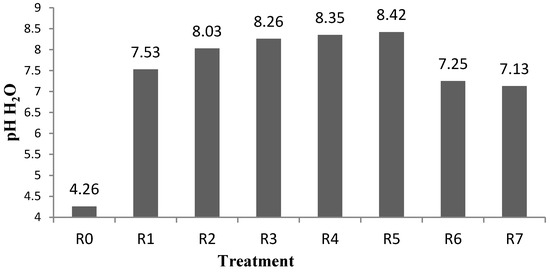
Figure 1.
Soil pH after incubation with red mud and cow manure treatments.
3.2.2. Organic Carbon in Soil after Incubation
Table 2 indicates that increasing the amount of cow manure added up to treatment R7 (combination of 60% Ultisol soil + 15% red mud + 25% cow manure) can enhance soil organic carbon (C-organic) compared to the control without the addition of red mud and cow manure. Although red mud has low levels of C-organic, when combined with cow manure, which has a high C-organic content of 34.22%, it can increase soil organic carbon. Figure 2 presents the effect of the combination of red mud and cow manure on soil organic carbon.
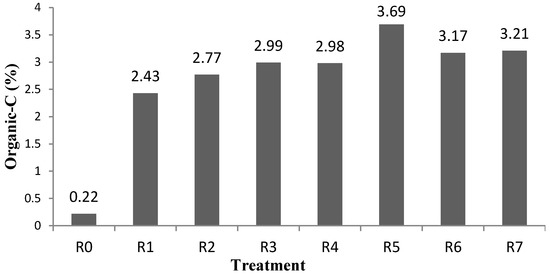
Figure 2.
Soil organic carbon after incubation with red mud and cow manure treatments.
3.2.3. Total Nitrogen in Soil after Incubation
Table 2 reveals that the addition of red mud and cow manure can increase total soil nitrogen compared to the control soil, which had a nitrogen content of 0.03%. Treatment R5 (combination of 70% Ultisol soil + 10% red mud + 20% cow manure) resulted in the highest increase in total soil nitrogen after incubation compared to other treatments. However, increasing the amount of red mud and cow manure in treatment R6 (70% Ultisol soil + 15% red mud + 15% cow manure) and treatment R7 (60% Ultisol soil + 15% red mud + 25% cow manure) led to a decrease in total soil nitrogen.
The decrease in total soil nitrogen due to increasing amounts of red mud and cow manure is likely caused by a decrease in soil organic carbon, which slows down the mineralization processes. Nitrogen (N) is mainly derived from the decomposition of organic matter, and its contribution depends on the quality and quantity of the organic matter [44]. Decomposition rates are affected by soil pH, and an increase in pH can decrease nitrogen availability [45,46,47]. The contribution of nitrogen from air fixation in the soil is relatively low, around 117 kg/ha/year [48]. Organic fertilizers undergo hydrolysis, mineralization, and nitrification processes, reaching maximum accumulation of N-NO3- after 14 days of incubation [49,50,51]. Figure 3 depicts the effect of the combination of red mud and cow manure on total soil nitrogen.
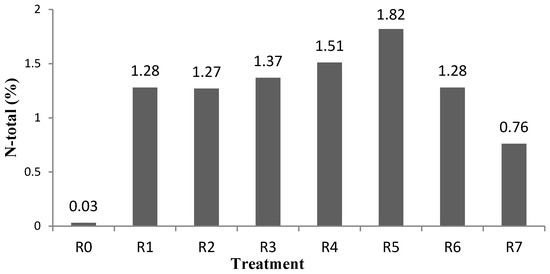
Figure 3.
Total soil nitrogen after incubation with the combination of red mud and cow manure treatments.
3.2.4. Phosphorus in Soil after Incubation
Table 2 demonstrates that the addition of red mud and cow manure can increase available phosphorus in the soil compared to the control soil, which had an available phosphorus content of 13.49 ppm. The addition of increasing amounts of red mud and cow manure in treatment R7 (60% Ultisol soil + 15% red mud + 25% cow manure) resulted in the highest increase in available phosphorus (46.29 ppm) compared to other treatments.
The decrease in available phosphorus in other treatments may be due to an increase in soil pH, which enhances the solubility of base cations, particularly calcium (Ca) ions. This can result in the binding of phosphate ions to calcium ions, leading to reduced phosphorus availability [52,53]. Additionally, high levels of organic matter from cow manure can promote phosphorus fixation and reduce its availability [54]. Figure 4 illustrates the effect of the combination of red mud and cow manure on available phosphorus.
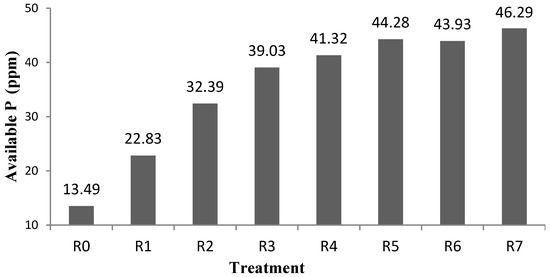
Figure 4.
Displays the available P in the soil after incubation with the combination of red mud and cow manure treatments.
3.2.5. Potassium in Soil after Incubation
Table 2 shows that the application of red mud and cow manure fertilizer can increase the exch. K in the soil compared to the untreated soil. The exch. K content in the untreated soil was 1.10 cmol kg (+) kg−1, while the exch. K content after treatment ranged from 1.17 cmol kg (+) kg−1 to 2.34 cmol kg (+) kg−1. The application of red mud and cow manure fertilizer gradually increased up to the R5 treatment (combination of 70% Ultisol soil + 10% red mud + 20% cow manure fertilizer), which showed the highest exch. K in the soil. However, it was not significantly different from the R4 treatment (80% Ultisol soil + 10% red mud + 10% cow manure fertilizer). This is because red mud and cow manure fertilizer contain K, which increases the exch. K in the soil upon addition [55,56]. Moreover, the high proportion of clay minerals in the added red mud (36.58%) provides a significant potential for the exch. K in the soil.
In addition to being a source of K nutrients, the high proportion of clay minerals in red mud added to the soil provides great potential for exch. K. The effect of the combination of red mud and cow manure fertilizer treatments on the exch. K in the soil is shown in Figure 5.

Figure 5.
Displays the exch. K in the soil after incubation with the combination of red mud and cow manure treatments.
3.2.6. Calcium in Soil after Incubation
Table 2 shows that the application of red mud and cow manure fertilizer can increase the exch. Ca in the soil compared to the untreated soil. The exch. Ca content in the untreated soil was 0.24 cmol kg (+) kg−1, while the exch. Ca content after treatment ranged from 4.81 cmol kg (+) kg−1 to 25.55 cmol kg (+) kg−1. The R5 treatment (combination of 70% Ultisol soil + 10% red mud + 20% cow manure fertilizer) showed the highest exch. Ca in the soil. However, it was not significantly different from the R3 treatment (85% Ultisol soil + 5% red mud + 10% cow manure fertilizer) and the R4 treatment (80% Ultisol soil + 10% red mud + 10% cow manure fertilizer). This is because red mud contains 4.22 cmol (+) kg−1 of Ca, which is higher than the content of other base cations (K, Mg, and Na), making it a potential source of Ca. Additionally, pH and CEC of the soil are essential factors in determining the exch. Ca in the soil [57,58]. The effect of the combination of red mud and cow manure fertilizer treatments on the exch. Ca in the soil is shown in Figure 6.
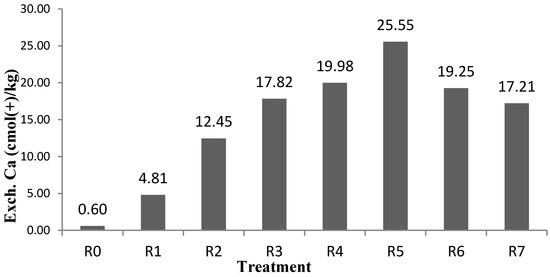
Figure 6.
Displays the exch. Ca in the soil after incubation with the combination of red mud and cow manure treatments.
3.2.7. Magnesium in Soil after Incubation
Table 2 shows that the application of red mud and cow manure fertilizer can increase the exch. Mg in the soil compared to the untreated soil [59,60]. The exch. Mg content in the untreated soil was 0.04 cmol kg (+) kg−1, while the exch. Mg content after treatment ranged from 2.65 cmol kg (+) kg−1 to 4.07 cmol kg (+) kg−1. The R3 treatment (85% Ultisol soil + 5% red mud + 10% cow manure fertilizer) did not differ significantly from the R4 treatment (80% Ultisol soil + 10% red mud + 10% cow manure fertilizer) and the R5 treatment (70% Ultisol soil + 10% red mud + 20% cow manure fertilizer) in terms of exch. Mg in the soil. However, the highest exch. Mg was observed in the R7 treatment (60% Ultisol soil + 15% red mud + 25% cow manure fertilizer), although it did not differ significantly from the R6 treatment (70% Ultisol soil + 15% red mud + 15% cow manure fertilizer). The exch. Mg in the soil increased with the increasing application of red mud and cow manure fertilizer. This is because red mud contains Mg, which can serve as a source of Mg. The effect of the combination of red mud and cow manure fertilizer treatments on the exch. Mg in the soil is shown in Figure 7.
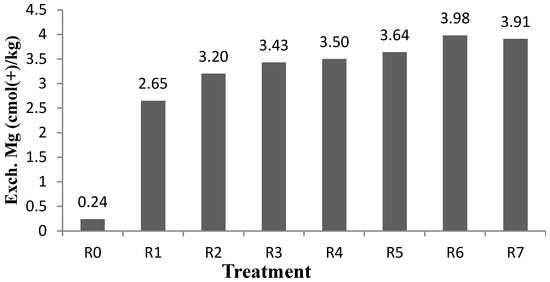
Figure 7.
Displays the exch. Mg in the soil after incubation with the combination of red mud and cow manure treatments.
3.2.8. Sodium in Soil after Incubation
Table 2 shows that the application of red mud and cow manure fertilizer can increase the exch. Na in the soil compared to the untreated soil [61]. The exch. Na content in the untreated soil was 2.25 cmol kg (+) kg−1, while the exch. Na content after treatment ranged from 5.20 cmol kg (+) kg−1 to 8.41 cmol kg (+) kg−1. The R4 treatment (80% Ultisol soil + 10% red mud + 10% cow manure fertilizer) did not differ significantly from the R5 treatment (70% Ultisol soil + 10% red mud + 20% cow manure fertilizer), R6 treatment (70% Ultisol soil + 15% red mud + 15% cow manure fertilizer), and R7 treatment (60% Ultisol soil + 15% red mud + 25% cow manure fertilizer) after incubation. The exch. Na in the soil increased with the increasing application of red mud and cow manure fertilizer up to 15% and 25%. This is because red mud and cow manure fertilizer contain Na, which can serve as a source of exch. Na in the soil. However, Na is weakly retained by organic or mineral matter [62,63]. The effect of the combination of red mud and cow manure fertilizer treatments on the exch. Na in the soil is shown in Figure 8.
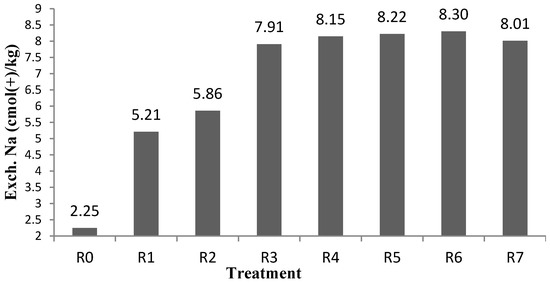
Figure 8.
Displays the exch. Na in the soil after incubation with the combination of red mud and cow manure fertilizer treatments.
3.2.9. Cation Exchange Capacity (CEC) in Soil after Incubation
Table 2 shows that the application of red mud and cow manure fertilizer can increase the cation exchange capacity (CEC) of the soil compared to the untreated soil [64]. The CEC content in the untreated soil was 6.78 cmol kg (+) kg−1, while the CEC content after treatment ranged from 10.43 cmol kg (+) kg−1 to 13.28 cmol kg (+) kg−1. The R2 treatment (95% Ultisol soil + 5% red mud) increased the CEC of the soil after incubation compared to without the addition of red mud. However, the R7 treatment (60% Ultisol soil + 15% red mud + 25% cow manure fertilizer) significantly decreased the CEC of the soil. The highest CEC value was observed in the R5 treatment (10% red mud + 20% cow manure fertilizer), although it did not differ significantly from the R4 treatment (10% red mud + 10% cow manure fertilizer) and R6 treatment (70% Ultisol soil + 15% red mud + 15% cow manure fertilizer) [65]. The increase in CEC of the soil was due to the increasing application of cow manure fertilizer, which has a high organic carbon content (34.22%) that can increase the organic carbon in the soil. The CEC value of the soil is directly related to the amount of organic matter in the soil [65]. One source of negative charge in the soil is organic matter, which comes from the dissociation of functional groups of organic acids. The CEC of humus can reach 150–300 cmol (+) kg−1 [66]. The effect of the combination of red mud and cow manure fertilizer treatments on the CEC of the soil is shown in Figure 9.
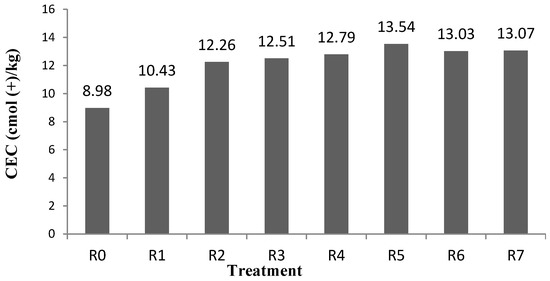
Figure 9.
Illustrates the cation exchange capacity (CEC) of soil after incubation with a combination of red mud and cow manure.
3.2.10. Base Saturated (BS) Soil after Incubation
Table 2 shows that the application of red mud and cow manure fertilizers can significantly increase the soil’s base saturated (BS) compared to the untreated soil. The BS value of the untreated soil was 46.65 cmol kg (+) kg−1, which increased to a range of 132.67 cmol kg (+) kg−1 to 293.83 cmol kg (+) kg−1 after treatment. Treatment R2 (95% Ultisol soil + 5% red mud) was found to increase the soil’s BS after incubation compared to the untreated soil. However, significant increases in BS were observed with the addition of red mud up to 15% and cow manure fertilizer at 25% kg (treatment R7). This can be attributed to the presence of basic cations such as K, Ca, Mg, and Na in red mud, which contributes to its high BS value of 96.83%, compared to the untreated Ultisol soil BS of approximately 3.7%. Base saturation (BS) is a measure of the percentage of total cation exchange capacity occupied by basic cations such as K, Ca, Mg, and Na [67,68]. The results suggest that red mud and cow manure fertilizers can be used as effective soil amendments to improve soil fertility and productivity by increasing the soil’s BS value (Figure 10).
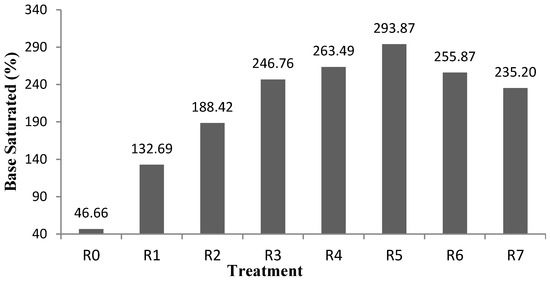
Figure 10.
Shows the base saturated (BS) of the soil after incubation with a combination of red mud and cow manure fertilizers.
3.3. Growth Parameters of Albizia falcata Trees
3.3.1. Plant Height Increment of Albizia falcata at Week 10 after Planting
The growth parameters, including plant height and stem diameter (average of six Albizia falcata seedlings per treatment), are measurements of the increase in height and stem diameter compared to the initial measurements of the Albizia falcata seedlings used (height of 62 cm and diameter of 0.40 cm). This study evaluates the impact of red mud and cow manure fertilizers on the height and stem diameter of Albizia falcata trees. The research findings are presented in Table 3.

Table 3.
Plant height and stem diameter increment due to the influence of red mud and cow manure fertilizer treatment.
Table 3 shows that treatment R1 (95% Ultisol soil + 5% red mud) increased the height of Albizia falcata trees compared to the control, although there was no significant difference with treatment R2 (90% Ultisol soil + 5% red mud + 5% cow manure fertilizer). Treatment R5 (70% Ultisol soil + 10% red mud + 20% cow manure fertilizer) resulted in the highest height increment, as the N content in the Albizia falcata tree tissues was also highest in this treatment. High nitrogen content can improve vegetative growth (height, stem diameter, leaf number, leaf area, shoot number, root number, and root length) [69,70] because nitrogen functions to increase leaf number and area [71]. In addition, the leaf surface area also affects the photosynthesis process [70,72].
The application of red mud and cow manure fertilizers can increase the height of Albizia falcata trees up to a certain dosage. There was a tendency for a decrease in tree height with increasing doses of red mud and cow manure fertilizers as the macronutrient levels that play a role in plant growth also decreased. The effect of combined red mud and cow manure fertilizer treatments on Albizia falcata tree height increment can be seen in Figure 11.
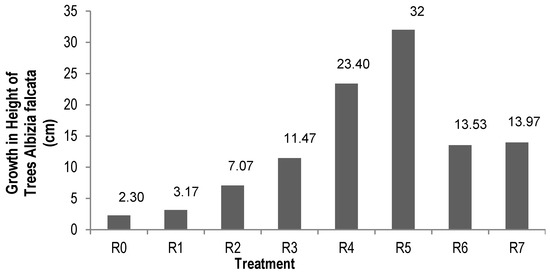
Figure 11.
Plant height increment of Albizia falcata at Week 10 after planting.
3.3.2. Stem Diameter Increment of Albizia falcata at Week 10 after Planting
Table 2 shows that treatment R1 (95% Ultisol soil + 5% Red Mud) increased the height of Albizia falcata trees compared to the control, although there was no significant difference with treatments R2 (90% Ultisol soil + 5% red mud + 5% cow manure fertilizer). The present study investigated the effects of red mud and cow manure on the growth of plants, specifically in terms of stem diameter. Results showed that the R5 treatment, consisting of Ultisol soil (70%), red mud (10%), and cow manure fertilizer (20%), resulted in the highest and significantly different increase in stem diameter compared to other treatments, except for the R4 treatment (red mud 10% + cow manure 10%). The combination of red mud and cow manure in the R5 treatment was found to promote stem diameter growth. However, there was a decreasing trend in stem diameter growth with increasing amounts of red mud and cow manure until the R7 treatment (red mud 15% + cow manure 25%). This could be attributed to a reduction in macronutrient levels, which play a crucial role in plant growth. Overall, the results suggest that the R5 treatment is the most effective in promoting stem diameter growth in plants.
Sufficient available nutrients in the soil can affect plant physiology and metabolism processes better and improve plant growth [73,74]. Moreover, an increase in soluble nutrients in the soil can increase the absorption of nutrients by plants for their growth [75,76]. The effect of combined red mud and cow manure fertilizer treatments on Albizia falcata tree stem diameter increment can be seen in Figure 12.
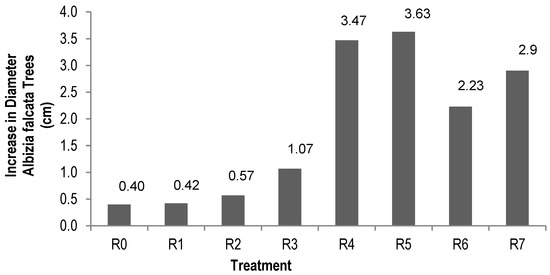
Figure 12.
Stem diameter increment of Albizia falcata at Week 10 After planting.
4. Conclusions
Sustainable rehabilitation of post-bauxite mining land can be successfully executed by employing site-specific amelioration technologies, which capitalize on red mud waste and organic compounds such as cow manure fertilizer. This strategy serves as an efficient tool for mitigating the adverse effects associated with bauxite mining and processing. By mitigating land degradation and curbing the accumulation of red mud waste, this approach simultaneously boosts nutrient availability and encourages the proliferation of Albizia falcata plants.
The findings of this study show that an amalgamation of 10% red mud and 20% cow manure fertilizer significantly amplified soil pH levels by over twice the initial value (an increase of 97.65%). This intervention also resulted in improved availability of key nutrients (N, P, K, Ca, Mg, and Na), with an observed increase ranging from 2 to 60 times (an increment of 116.36% to 5966.67%). This led to a substantial improvement in the growth of Albizia falcata plants by factors ranging from 8 to 13 times (an increase of 807.50% to 1291.30%) when compared to the control in post-bauxite mining land.
The focus of this study was exclusively on the rehabilitation of post-bauxite mining land in PT Antam, Sanggau Regency, West Kalimantan. The study involved Albizia falcata plants and used red mud and cow manure as the chosen ameliorants. Parameters observed were confined to macro-nutrient availability and plant growth factors, including plant height and stem diameter. The duration of the research was one year. Nevertheless, it is recommended that future research expands the area of study, includes additional plant species, examines treatments with different ameliorants, and broadens the scope of observed variables. For a holistic understanding and to evaluate the sustainability and economic potential of this rehabilitation method, a more exhaustive environmental assessment, coupled with a cost-benefit analysis with respect to the government, the industry, and the local community, is advised.
Author Contributions
Writing—original draft, D.S.; Writing—review & editing, N.I.D. All authors have read and agreed to the published version of the manuscript.
Funding
This research was funded by the Directorate General of Higher Education (DIKTI) grant number: 101/SP2H/LT/DRPM/2019.
Data Availability Statement
Data will be made available on request.
Acknowledgments
The authors would like to express their gratitude to the Directorate General of Higher Education (DIKTI) for funding this research through the National Priority Research Program of MP3EI (Masterplan for the Acceleration and Expansion of Indonesia’s Economic Development), which enabled this research to be conducted.
Conflicts of Interest
The authors declare no conflict of interest.
References
- Kuan, S.H.; Ghorbani, Y.; Chieng, S. Narrowing the gap between local standards and global best practices in bauxite mining: A case study in Malaysia. Resour. Policy 2020, 66, 101636. [Google Scholar] [CrossRef]
- Saevarsdottir, G.; Kvande, H.; Welch, B.J. Aluminum production in the times of climate change: The global challenge to reduce the carbon footprint and prevent carbon leakage. JOM 2020, 72, 296–308. [Google Scholar] [CrossRef]
- Narendra, B.H.; Siregar, C.A.; Turjaman, M.; Hidayat, A.; Rachmat, H.H.; Mulyanto, B.; Susilowati, A. Managing and reforesting degraded post-mining landscape in Indonesia: A Review. Land 2021, 10, 658. [Google Scholar]
- Worlanyo, A.S.; Jiangfeng, L. Evaluating the environmental and economic impact of mining for post-mined land restoration and land-use: A review. J. Environ. Manag. 2021, 279, 111623. [Google Scholar] [CrossRef] [PubMed]
- Chen, Z.; Yang, Y.; Zhou, L.; Hou, H.; Zhang, Y.; Liang, J.; Zhang, S. Ecological restoration in mining areas in the context of the Belt and Road initiative: Capability and challenges. Environ. Impact Assess. Rev. 2022, 95, 106767. [Google Scholar] [CrossRef]
- Dou, S.; Xu, D.; Keenan, R.J. Effect of income, industry structure and environmental regulation on the ecological impacts of mining: An analysis for Guangxi Province in China. J. Clean. Prod. 2023, 400, 136654. [Google Scholar] [CrossRef]
- Dong, L.; Tong, X.; Li, X.; Zhou, J.; Wang, S.; Liu, B. Some developments and new insights of environmental problems and deep mining strategy for cleaner production in mines. J. Clean. Prod. 2019, 210, 1562–1578. [Google Scholar] [CrossRef]
- Cai, M.; Li, P.; Tan, W.; Ren, F. Key engineering technologies to achieve green, intelligent, and sustainable development of deep metal mines in China. Engineering 2021, 7, 1513–1517. [Google Scholar] [CrossRef]
- Santillán-Saldivar, J.; Gaugler, T.; Helbig, C.; Rathgeber, A.; Sonnemann, G.; Thorenz, A.; Tuma, A. Design of an endpoint indicator for mineral resource supply risks in life cycle sustainability assessment: The case of Li-ion batteries. J. Ind. Ecol. 2021, 25, 1051–1062. [Google Scholar] [CrossRef]
- Kofi, A.S.; Loveridge, A.D.S.; Obed, A.; Oduro, N.B.; Yah, A.D.T.R. The Contributions of Ghana’s Minerals Resources to the Global Economy: Using Bauxite as a Case Study. N. Am. Acad. Res. 2023, 6, 71–86. [Google Scholar]
- Yeboah, S.; James Nyarkoh, B. The Impact of Mining on the Ghanaian Economy: A Comprehensive Review (1992–2020); MPRA Paper; University Library of Munich: Munich, Germany, 2022; pp. 1–21. [Google Scholar]
- Leslie, T. Chicago Skyscrapers, 1934–1986: How Technology, Politics, Finance, and Race Reshaped the City; University of Illinois Press: Champaign, IL, USA, 2023. [Google Scholar]
- Kratz, N. 10.4 Structural ceramics. In From Magnetic to Bioactive Materials; Walter de Gruyter GmbH & Co KG: Berlin, Germany, 2022; Volume 231. [Google Scholar]
- Ghosh, D.; Maiti, S.K. Biochar-assisted eco-restoration of coal mine degraded land to meet United Nation Sustainable Development Goals. Land Degrad. Dev. 2021, 32, 4494–4508. [Google Scholar] [CrossRef]
- Yuan, C.; Wu, F.; Wu, Q.; Fornara, D.A.; Heděnec, P.; Peng, Y.; Zhu, G.; Zhao, Z.; Yue, K. Vegetation restoration effects on soil carbon and nutrient concentrations and enzymatic activities in post-mining lands are mediated by mine type, climate, and former soil properties. Sci. Total Environ. 2023, 879, 163059. [Google Scholar] [CrossRef]
- Ujaczki, É.; Feigl, V.; Molnár, M.; Cusack, P.; Curtin, T.; Courtney, R.; O’Donoghue, L.; Davris, P.; Hugi, C.; Evangelou, M.W.; et al. Re-using bauxite residues: Benefits beyond (critical raw) material recovery. J. Chem. Technol. Biotechnol. 2018, 93, 2498–2510. [Google Scholar] [CrossRef] [PubMed]
- Tibbett, M. Mining in Ecologically Sensitive Landscapes; CSIRO Publishing: Clayton, Australia, 2015. [Google Scholar]
- Eldridge, D.J.; Oliver, I.; Powell, J.R.; Dorrough, J.; Carrillo, Y.; Nielsen, U.N.; Macdonald, C.A.; Wilson, B.; Fyfe, C.; Amarasinghe, A.; et al. Temporal dynamics in biotic and functional recovery following mining. J. Appl. Ecol. 2022, 59, 1632–1643. [Google Scholar] [CrossRef]
- Mentis, M. Environmental rehabilitation of damaged land. For. Ecosyst. 2020, 7, 19. [Google Scholar] [CrossRef]
- Spitz, K.; Trudinger, J.; Orr, M. Environmental Social Governance: Managing Risk and Expectations; CRC Press: Boca Raton, FL, USA, 2022. [Google Scholar]
- Rodriguez, I. Latin American decolonial environmental justice. In Environmental Justice; Routledge: Abingdon, UK, 2020; pp. 78–93. [Google Scholar]
- Shroff, F.M. Light at the End of the Tunnel: Mining Justice and Health. Public Health Open J. 2023, 8, 1–12. [Google Scholar]
- Skousen, J.; Zipper, C.E. Coal mining and reclamation in Appalachia. In Appalachia’s Coal-Mined Landscapes: Resources and Communities in a New Energy Era; Springer: Berlin/Heidelberg, Germany, 2021; pp. 55–83. [Google Scholar]
- Xu, Z.; Lu, Z.; Zhang, L.; Fan, H.; Wang, Y.; Li, J.; Lin, Y.; Liu, H.; Guo, S.; Xu, M.; et al. Red mud based passivator reduced Cd accumulation in edible amaranth by influencing root organic matter metabolism and soil aggregate distribution. Environ. Pollut. 2021, 275, 116543. [Google Scholar] [CrossRef]
- Hashim, K.S.; Shaw, A.; AlKhaddar, R.; Kot, P.; Al-Shamma’a, A. Water purification from metal ions in the presence of organic matter using electromagnetic radiation-assisted treatment. J. Clean. Prod. 2021, 280, 124427. [Google Scholar] [CrossRef]
- Li, Y.; Gong, X. Effects of dissolved organic matter on the bioavailability of heavy metals during microbial dissimilatory iron reduction: A review. Rev. Environ. Contam. Toxicol. 2021, 257, 69–92. [Google Scholar]
- Nugraha, G.; dan Herawatiningsih, R.; Nugroho, J.R. Evaluasi Kesesuaian Lahan Gambut Untuk Tanaman Albizia falcata di Desa Kuala Dua Kec. Sungai Raya Kab. Kubu Raya. J. Hutan Lestari 2013, 1, h141–h148. [Google Scholar]
- Prematuri, R.; Turjaman, M.; Sato, T.; Tawaraya, K. Post Bauxite Mining Land Soil Characteristics and Its Effects on the Growth of Albizia moluccana (Miq.) Barneby & JW Grimes and Albizia saman (Jacq.) Merr. Appl. Environ. Soil Sci. 2020, 2020, 6764380. [Google Scholar]
- Putra, R.D.; Apriadi, T.; Suryanti, A.; Irawan, H.; Raja, T.S.; Yulianto, T.; Atmadja, W.K.; Koenawan, C.J. Preliminary study of heavy metal (Zn, Pb, Cr, As, Cu, Cd) contaminations on different soil level from post-mining bauxite production for aquaculture. E3S Web Conf. 2018, 47, 02008. [Google Scholar] [CrossRef]
- Morales-Muñoz, H.; Bailey, A.; Löhr, K.; Caroli, G.; Villarino, M.E.J.; LoboGuerrero, A.M.; Bonatti, M.; Siebert, S.; Castro-Nuñez, A. Co-Benefits Through Coordination of Climate Action and Peacebuilding: A System Dynamics Model. J. Peacebuilding Dev. 2022, 17, 304–323. [Google Scholar] [CrossRef]
- Lubchenco, J.; Haugan, P.M. Coastal Development: Resilience, Restoration and Infrastructure Requirements. In The Blue Compendium: From Knowledge to Action for a Sustainable Ocean Economy; Springer International Publishing: Cham, Switzerland, 2023; pp. 213–277. [Google Scholar]
- Bönecke, E.; Meyer, S.; Vogel, S.; Schröter, I.; Gebbers, R.; Kling, C.; Kramer, E.; Lück, K.; Nagel, A.; Philipp, G.; et al. Guidelines for precise lime management based on high-resolution soil pH, texture and SOM maps generated from proximal soil sensing data. Precis. Agric. 2021, 22, 493–523. [Google Scholar] [CrossRef]
- Anand, S. Soil organic carbon: Associating the Walkley-Black wet oxidation method to loss on ignition (gravimetric method) and clay content for selected Samoan inceptisols. Eur. J. Appl. Sci. 2022, 10, 219–227. [Google Scholar]
- Lou, J.; Zhang, J.; Xu, S.; Wang, D.; Fan, X. New Method to Evaluate the Crosslinking Degree of Resin Finishing Agent with Cellulose Using Kjeldahl Method and Arrhenius Formula. Processes 2021, 9, 767. [Google Scholar] [CrossRef]
- McDowell, R.W.; Noble, A.; Pletnyakov, P.; Haygarth, P.M. A Global Database of Soil Plant Available Phosphorus. Sci. Data 2023, 10, 125. [Google Scholar] [CrossRef]
- Irabor, E.E.I.; Unuigbe, C.A.; Omoruyi, U.; EhimikhuaI, K.O.; Sama, F.J. Evaluation Of The Available Plant Nutrients At Different pH Levels Of Ahokor Clay Deposit Located In Kogi State, Nigeria. J. Chem. Soc. Niger. 2020, 45, 680–686. [Google Scholar] [CrossRef]
- El Bourhrami, B.; Ibno Namr, K.; Et-Tayeb, H.; Duraisamy, V. Application of Soil Quality Index to Assess the Status of Soils Submitted to Intensive Agriculture in the Irrigated Plain of Doukkala, Moroccan Semiarid Region. Ecol. Eng. Environ. Technol. 2022, 23, 129–143. [Google Scholar] [CrossRef]
- Floro, M.J.C.; Gavino, P.G.; Villareal, E.P.; Gavino, N.T.; Onapan, M.S.I.F. Growth and Yield Response of Okra (Hibiscus esculentus Linn.) Applied with Foliar Fertilizers and Vermicast. CapSU Res. J. 2019, 29, 71–79. [Google Scholar]
- Chia, K.A.; Koch, J.M.; Sadler, R.; Turner, S.R. Re-establishing the mid-storey tree Persoonia longifolia (Proteaceae) in restored forest following bauxite mining in southern Western Australia. Ecol. Res. 2016, 31, 627–638. [Google Scholar] [CrossRef]
- Zhu, F.; Cheng, Q.; Xue, S.; Li, C.; Hartley, W.; Wu, C.; Tian, T. Influence of natural regeneration on fractal features of residue microaggregates in bauxite residue disposal areas. Land Degrad. Dev. 2018, 29, 138–149. [Google Scholar] [CrossRef]
- Kong, X.; Tian, T.; Xue, S.; Hartley, W.; Huang, L.; Wu, C.; Li, C. Development of alkaline electrochemical characteristics demonstrates soil formation in bauxite residue undergoing natural rehabilitation. Land Degrad. Dev. 2018, 29, 58–67. [Google Scholar] [CrossRef]
- Dinh, Q.T.; Li, Z.; Tran, T.A.T.; Wang, D.; Liang, D. Role of organic acids on the bioavailability of selenium in soil: A review. Chemosphere 2017, 184, 618–635. [Google Scholar] [CrossRef] [PubMed]
- Hafifah, H.; Sudiarso, S.; Maghfoer, M.D.; Prasetya, B. The potential of Tithonia diversifolia green manure for improving soil quality for cauliflower (Brassica oleracea var. Brotrytis L.). J. Degrad. Min. Lands Manag. 2016, 3, 499. [Google Scholar]
- Hu, Y.; Zheng, Q.; Noll, L.; Zhang, S.; Wanek, W. Direct measurement of the in situ decomposition of microbial-derived soil organic matter. Soil Biol. Biochem. 2020, 141, 107660. [Google Scholar] [CrossRef]
- Averill, C.; Waring, B. Nitrogen limitation of decomposition and decay: How can it occur? Glob. Chang. Biol. 2018, 24, 1417–1427. [Google Scholar] [CrossRef]
- Vanzolini, J.I.; Galantini, J.A.; Martínez, J.M.; Suñer, L. Changes in soil pH and phosphorus availability during decomposition of cover crop residues. Arch. Agron. Soil Sci. 2017, 63, 1864–1874. [Google Scholar] [CrossRef]
- Curran, W.S. Persistence of herbicides in soil. Crops Soils 2016, 49, 16–21. [Google Scholar] [CrossRef]
- Hamlin, Q.F.; Kendall, A.D.; Martin, S.L.; Whitenack, H.D.; Roush, J.A.; Hannah, B.A.; Hyndman, D.W. Quantifying landscape nutrient inputs with spatially explicit nutrient source estimate maps. J. Geophys. Res. Biogeosci. 2020, 125, e2019JG005134. [Google Scholar] [CrossRef]
- Guan, P.; Wang, R.; Nkoh, J.N.; Shi, R.; Pan, X.; Li, J.; Xu, R. Enriching organic carbon bioavailability can mitigate soil acidification induced by nitrogen fertilization in croplands through microbial nitrogen immobilization. Soil Sci. Soc. Am. J. 2022, 86, 579–592. [Google Scholar] [CrossRef]
- Paillat, L.; Cannavo, P.; Barraud, F.; Huché-Thélier, L.; Guénon, R. Growing medium type affects organic fertilizer mineralization and CNPS microbial enzyme activities. Agronomy 2020, 10, 1955. [Google Scholar] [CrossRef]
- Sentek, V.; Velescu, A.; Wilcke, W.; Henke, C.; Peters, N.; Welp, G.; Amelung, W. Nitrogen release from different polymer-coated urea fertilizers in soil is affected by soil properties. Soil Use Manag. 2023, 1–14. [Google Scholar] [CrossRef]
- Mahboubi, M. Tribulus Terrestris and its Efficacy in the Treatment of Urinary Calculi. Nat. Prod. J. 2022, 12, 2–10. [Google Scholar] [CrossRef]
- Bouremani, N.; Cherif-Silini, H.; Silini, A.; Bouket, A.C.; Luptakova, L.; Alenezi, F.N.; Baranov, O.; Belbahri, L. Plant Growth-Promoting Rhizobacteria (PGPR): A Rampart against the Adverse Effects of Drought Stress. Water 2023, 15, 418. [Google Scholar] [CrossRef]
- Peng, G.A.O.; Zhang, T.; Lei, X.Y.; Cui, X.W.; Lu, Y.X.; Fan, P.F.; Long, S.-P.; Huang, J.; Gao, J.-S.; Zhang, Z.-H.; et al. Improvement of soil fertility and rice yield after long-term application of cow manure combined with inorganic fertilizers. J. Integr. Agric. 2023. [Google Scholar] [CrossRef]
- Barthod, J.; Rumpel, C.; Calabi-Floody, M.; Mora, M.L.; Bolan, N.S.; Dignac, M.F. Adding worms during composting of organic waste with red mud and fly ash reduces CO2 emissions and increases plant available nutrient contents. J. Environ. Manag. 2018, 222, 207–215. [Google Scholar] [CrossRef]
- Guo, L.; Wu, G.; Li, Y.; Li, C.; Liu, W.; Meng, J.; Liu, H.; Yu, X.; Jiang, G. Effects of cattle manure compost combined with chemical fertilizer on topsoil organic matter, bulk density and earthworm activity in a wheat–maize rotation system in Eastern China. Soil Tillage Res. 2016, 156, 140–147. [Google Scholar] [CrossRef]
- Hailegnaw, N.S.; Mercl, F.; Pračke, K.; Száková, J.; Tlustoš, P. Mutual relationships of biochar and soil pH, CEC, and exchangeable base cations in a model laboratory experiment. J. Soils Sediments 2019, 19, 2405–2416. [Google Scholar] [CrossRef]
- Havlin, J.L. Soil: Fertility and nutrient management. In Landscape and Land Capacity; CRC Press: Boca Raton, FL, USA, 2020; pp. 251–265. [Google Scholar]
- Gul, S.; Naz, A.; Fareed, I.; Irshad, M. Reducing heavy metals extraction from contaminated soils using organic and inorganic amendments—A review. Pol. J. Environ. Stud. 2015, 24, 1423–1426. [Google Scholar]
- Lwin, C.S.; Seo, B.H.; Kim, H.U.; Owens, G.; Kim, K.R. Application of soil amendments to contaminated soils for heavy metal immobilization and improved soil quality—A critical review. Soil Sci. Plant Nutr. 2018, 64, 156–167. [Google Scholar] [CrossRef]
- Reddy, P.S.; Reddy, N.G.; Serjun, V.Z.; Mohanty, B.; Das, S.K.; Reddy, K.R.; Rao, B.H. Properties and assessment of applications of red mud (bauxite residue): Current status and research needs. Waste Biomass Valorization 2021, 12, 1185–1217. [Google Scholar] [CrossRef]
- Zhou, Y.; Sherpa, S.; McBride, M.B. Pb and Cd chemisorption by acid mineral soils with variable Mn and organic matter contents. Geoderma 2020, 368, 114274. [Google Scholar] [CrossRef]
- Tisdall, J.M. Formation of soil aggregates and accumulation of soil organic matter. In Structure and Organic Matter Storage in Agricultural Soils; CRC Press: Boca Raton, FL, USA, 2020; pp. 57–96. [Google Scholar]
- Jain, M.S.; Kalamdhad, A.S. Soil revitalization via waste utilization: Compost effects on soil organic properties, nutritional, sorption and physical properties. Environ. Technol. Innov. 2020, 18, 100668. [Google Scholar] [CrossRef]
- Esmaeilzadeh, J.; Ahangar, A.G. Influence of soil organic matter content on soil physical, chemical and biological properties. Int. J. Plant Anim. Environ. Sci. 2014, 4, 244–252. [Google Scholar]
- Karthika, K.S.; Kumar, K.A.; Nair, K.M.; D’Souza, M.V.; Nagaraj, J.S.; Lalitha, M.; Arti, K.; Jayaramiah, M.; Parvathy, S.; Shivanand, K.; et al. Land quality and soil organic carbon stocks consequent to land use change from natural forest to coffee plantation in a hot humid tropical ecosystem of Western Ghats, South India: Is it restorative enough? Authorea 2020, 1–10. [Google Scholar] [CrossRef]
- Tiecher, T.; Gatiboni, L.; Santos, D.R.D.; Bissani, C.A.; Martins, A.P.; Gianello, C.; Dick, D.P.; Bortoluzzi, E.C.; Escosteguy, P.A.V.; da Silva, L.S.; et al. Base saturation is an inadequate term for Soil Science. Revista Brasileira de Ciência do Solo 2023, 46, 1–6. [Google Scholar] [CrossRef]
- Dos Santos, F.R.; de Oliveira, J.F.; Bona, E.; dos Santos, J.V.F.; Barboza, G.M.; Melquiades, F.L. EDXRF spectral data combined with PLSR to determine some soil fertility indicators. Microchem. J. 2020, 152, 104275. [Google Scholar] [CrossRef]
- Liu, S.; Li, X.; Larsen, D.H.; Zhu, X.; Song, F.; Liu, F. Drought priming at vegetative growth stage enhances nitrogen-use efficiency under post-anthesis drought and heat stress in wheat. J. Agron. Crop Sci. 2017, 203, 29–40. [Google Scholar] [CrossRef]
- Anas, M.; Liao, F.; Verma, K.K.; Sarwar, M.A.; Mahmood, A.; Chen, Z.L.; Li, Y.R. Fate of nitrogen in agriculture and environment: Agronomic, eco-physiological and molecular approaches to improve nitrogen use efficiency. Biol. Res. 2020, 53, 47. [Google Scholar] [CrossRef]
- Li, R.; Liu, P.; Dong, S.; Zhang, J.; Zhao, B. Increased maize plant population induced leaf senescence, suppressed root growth, nitrogen uptake, and grain yield. Agron. J. 2019, 111, 1581–1591. [Google Scholar] [CrossRef]
- Berger, K.; Verrelst, J.; Féret, J.B.; Wang, Z.; Wocher, M.; Strathmann, M.; Danner, M.; Mauser, W.; Hank, T. Crop nitrogen monitoring: Recent progress and principal developments in the context of imaging spectroscopy missions. Remote Sens. Environ. 2020, 242, 111758. [Google Scholar] [CrossRef] [PubMed]
- Timsina, J. Can organic sources of nutrients increase crop yields to meet global food demand? Agronomy 2018, 8, 214. [Google Scholar] [CrossRef]
- Weimers, K.; Bergstrand, K.J.; Hultberg, M.; Asp, H. Liquid anaerobic digestate as sole nutrient source in soilless horticulture—Or spiked with mineral nutrients for improved plant growth. Front. Plant Sci. 2022, 13, 443. [Google Scholar] [CrossRef] [PubMed]
- Zafar-ul-Hye, M.; Naeem, M.; Danish, S.; Fahad, S.; Datta, R.; Abbas, M.; Rahi, A.A.; Brtnicky, M.; Holátko, J.; Tarar, Z.H.; et al. Alleviation of cadmium adverse effects by improving nutrients uptake in bitter gourd through cadmium tolerant rhizobacteria. Environments 2020, 7, 54. [Google Scholar] [CrossRef]
- Bindraban, P.S.; Dimkpa, C.; Nagarajan, L.; Roy, A.; Rabbinge, R. Revisiting fertilisers and fertilisation strategies for improved nutrient uptake by plants. Biol. Fertil. Soils 2015, 51, 897–911. [Google Scholar] [CrossRef]
Disclaimer/Publisher’s Note: The statements, opinions and data contained in all publications are solely those of the individual author(s) and contributor(s) and not of MDPI and/or the editor(s). MDPI and/or the editor(s) disclaim responsibility for any injury to people or property resulting from any ideas, methods, instructions or products referred to in the content. |
© 2023 by the authors. Licensee MDPI, Basel, Switzerland. This article is an open access article distributed under the terms and conditions of the Creative Commons Attribution (CC BY) license (https://creativecommons.org/licenses/by/4.0/).